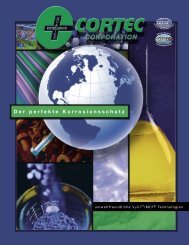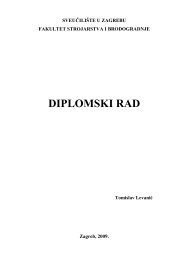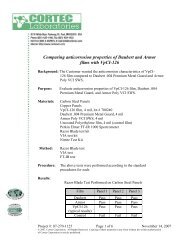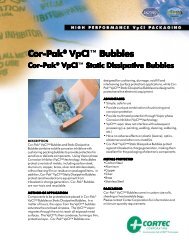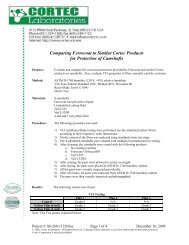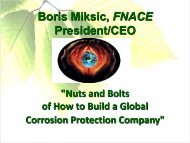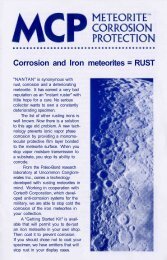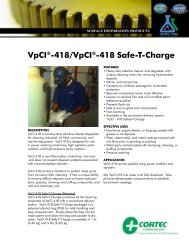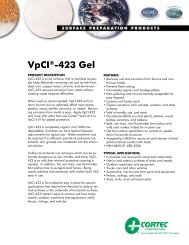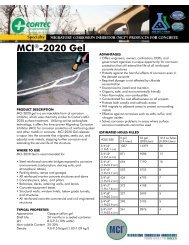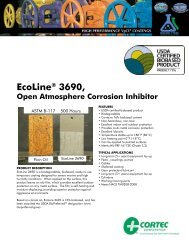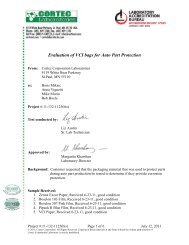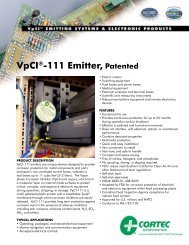Emitting Guide.pdf
Emitting Guide.pdf
Emitting Guide.pdf
Create successful ePaper yourself
Turn your PDF publications into a flip-book with our unique Google optimized e-Paper software.
VpCI SYSTEM APPLICATIONS<br />
Cortec Electricorr VpCI aerosol products and Cortec VpCI<br />
emitting devices are designed for use in interior enclosures that<br />
are covered, closed or sealed. Cortec's VpCI technology<br />
provides multi-metal protection against rust, corrosion,<br />
oxidation, and tarnishing. Cortec's VpCI Protection system can<br />
be used in both indoor and outdoor confined space<br />
applications. Length of protection depends on integrity of<br />
sealing and atmospheric conditions.<br />
VpCI SYSTEM PRODUCTS<br />
- ElectriCorr VpCI-248 Spray (Non<br />
flammable Inhibitor/Cleaner Antistat CFC Free)<br />
- VpCI-101 Emitter Strip (protects 1 Cubic Foot<br />
Enclosure)<br />
- VpCI-105 Emitter Cup (protects 5 Cubit Foot<br />
Enclosure)<br />
- VpCI-111 Emitter Cup (protects 11 Cubit Foot<br />
Enclosure)<br />
-Corrosorber (Hydrogen Sulfide scavenger)<br />
ElectriCorr VpCI-248 Cleaner<br />
- Non-flammable<br />
- Does not alter electrical resistance<br />
- Protects electronic/electrical contacts<br />
- Fast drying<br />
-Non-conductive<br />
-Excellent cleaning action<br />
VpCI Emitter Cup 105/111<br />
- One way Tyvek release membrane<br />
- Nitrite, silicone, and phosphate free<br />
- Economical protection<br />
- Long-lasting protection<br />
- Non-toxic<br />
- Easy installation<br />
- No residue<br />
VpCI PROTECTION<br />
SYSTEM FOR ELECTRICAL/<br />
ELECTRONIC ENCLOSURES<br />
1<br />
-<br />
Corrosorber Cup<br />
- Absorbs corrosive gases<br />
- Irreversible reaction<br />
- Non-toxic<br />
-Superior performance against<br />
Hydrogen Sulfide<br />
- Changes color as it is used up<br />
- Quick installation<br />
VpCI Foam Emitter 101<br />
- Patented VpCI impregnated foam<br />
- Continuous corrosion protection<br />
- Non-toxic<br />
- NSN #6850-01-338-1392<br />
- MIL-B-81705C<br />
- FDA & USDA Approved
VpCI VpCI VpCI Field Emitter Emitter Application T TTechnical<br />
T echnical Recommendations Support<br />
Support<br />
Common Common Questions<br />
Questions<br />
Electricorr VpCI-248 Method of Application -<br />
• Apply Electricorr VpCI-248 by lightly misting<br />
the entire interior surface or surfaces to be<br />
protected.<br />
• Apply in a “Z” pattern while misting to avoid<br />
running or sagging.<br />
• It is recommended to apply 30 cc of<br />
Electricorr VpCI-248 per cubic foot (1,059<br />
cc/ m3) of interior space to be protected. Coat<br />
product to a film thickness of 0.25-0.5 mils<br />
(6.25-12.5 microns).<br />
• Allow 15 minutes dry time before affixing<br />
emitters.<br />
VpCI Emitters Method of Application -<br />
Ensure the surface to which the device will be affixed<br />
is clean and free of debris.<br />
• Peel off the protective peel strip from the bottom<br />
of the device and attach it to the clean surface.<br />
• Install emitters per specification:<br />
VpCI-101 – 1 cubit foot protection<br />
VpCI-105 – 5 cubic feet protection<br />
VpCI-111 - 11 cubic feet protection<br />
• Devices can be installed in any position.<br />
• If the enclosure is not totally airtight, or if the<br />
access doors are opened frequently, replace the<br />
emitter devices as needed.<br />
• Under periods of heavy maintenance it is<br />
recommended to spray the enclosure very lightly<br />
with Cortec® Electricorr VpCI-248.<br />
• After application, cover, close, or seal the<br />
opening to the interior of the panel or enclosure.<br />
An airtight seal is not necessary.<br />
2<br />
• Protected surfaces should be contained in a way that<br />
prevents direct exposure to rain water spray, etc.<br />
Occasional opening of enclosure for brief periods will<br />
not adversely affect protection.<br />
• Record date when products were treated with<br />
Electricorr VpCI-248 and emitter products and<br />
attach dated marker to protected enclosure, box or<br />
container. Depending on atmospheric conditions and<br />
integrity of sealing, check condition of product at<br />
intervals of 6 and 12 months. Reapply as conditions<br />
warrant.<br />
Corrosorber Method of Application -<br />
• In environments where Hydrogen Sulfide is present, use<br />
Corrosorber in addition to emitters to absorb and<br />
scavenge corrosive gases.<br />
• Peel the protective strip from the bottom of the<br />
Corrosorber and affix to clean surface.<br />
• When Corrosorber needs to be replaced, the powder<br />
inside the cup will appear brown.<br />
Removal Method:<br />
Unless stated in the procedural steps, Electricorr VpCI-<br />
248 and emitting products typically do not require removal<br />
prior to product use. If removal is desired, remove with<br />
solvent suitable for electronics.<br />
Precautions:<br />
While applying Electricorr VpCI aerosol product,<br />
observe the accepted good practices for working with<br />
chemical liquids. Maintain adequate ventilation in work<br />
areas; wear suitable respirator, and hand and eye<br />
protection. Do not use on energized equipment
ASTM D-1748 (Humidity Chamber) Test Results<br />
No Protection vs. VpCI Protection<br />
ASTM D-1748 Standard Test Method for Rust Protection by Metal Preservation in the Humidity Cabinet<br />
This test method is used for evaluating the rust preventive properties of metal preservatives under conditions of<br />
high humidity. One circuit board was left untreated (Control) while the other was treated with Electricorr<br />
VpCI-248. The two boards were then suspended in a humidity cabinet at 120 degrees F (48.9 degrees C) for<br />
a period of four weeks. The criteria for passing or failing the test is the size and number of rust dots on the test<br />
surfaces.<br />
3
Cortec Technical Support<br />
<strong>Emitting</strong> Systems - Common Questions<br />
1. What is an “Emitter”?<br />
Emitters are devices (cups, foams, films, bags, etc.) which<br />
contain special compounds called VpCIs (Vapor phase<br />
Corrosion Inhibitors) which evaporate (emit) into the surrounding<br />
enclosure or package. This is much like water as it evaporates<br />
but it takes place over months or years instead of minutes or<br />
hours. Cortec generally refers to Emitters as those products<br />
that are individually packaged, such as our VpCI-101, VpCI-<br />
105, VpCI-111 or 1-MUL pouches and used in single<br />
applications. However, our VpCI-foams and films are often<br />
used in the same manner. In general, most Cortec products<br />
contain VpCIs and will act as emitters although they are not<br />
normally called emitters.<br />
2. How are Emitters Used?<br />
Emitters are used to protect enclosed metal components from<br />
corrosion by placing one or more of the devices in a container,<br />
package or other enclosure. This includes electronics cabinets<br />
of all types, computers and other electronic devices, electrical<br />
control boxes used for plant equipment, control boxes containing<br />
relays and switches, electronic gear aboard ships and airlines,<br />
tool boxes, spare parts boxes and storage units, fuse boxes,<br />
telecommunications devices, analytical equipment, gun cabinets<br />
and any other enclosure that contains metals that might corrode.<br />
They are also used extensively in shipping containers and<br />
packaging.<br />
3. How Does an Emitter or VpCI Work?<br />
The chemicals (VpCIs) which vaporize into a package or<br />
enclosure are usually a blend of several special compounds<br />
that form a very thin layer, only a few molecules thick, on the<br />
surface as they interact with all metals present. These chemicals<br />
are unique in that they prevent the interaction of air and water<br />
moisture with the metal, thus preventing corrosion.<br />
4<br />
4. What Will Emitters Do For Me? Why Use<br />
Emitters?<br />
Emitters will save money (and time) for almost any<br />
company using electronics or doing processing or<br />
manufacturing. They do this by reducing corrosion that<br />
affects production and product quality in several ways:<br />
· Emitters reduce electrical/electronic failures in<br />
relays, switches and connectors by preventing<br />
corrosion, the Number 1 cause for failure of<br />
electronic and electrical devices.<br />
· Reduce maintenance by reducing failures and<br />
parts replacement.<br />
· Extend equipment lifetime.<br />
·I mprove reliability by reducing noise levels,<br />
relay chatter and switch reliability and<br />
continuity.<br />
· Reduce accumulation of contaminants. The<br />
quality and performance of electronic devices<br />
will also improve in that they will look cleaner,<br />
function more reliably, and have lower<br />
electronic noise.<br />
5.How Long Does it Take for an Emitter to<br />
Become Effective?<br />
This depends on the size, shape and temperature of the<br />
enclosure. In general, at room temperature, emitters<br />
begin working immediately for metals immediately<br />
adjacent to them but it may require as much as 24 hours<br />
for metals at the extreme ends and internal spaces to<br />
become saturated with VpCI vapors.
Cortec Technical Support<br />
<strong>Emitting</strong> Systems - Common Questions<br />
6. How Can Emitters be Made Effective<br />
Sooner?<br />
This can be done in several ways:<br />
a. By using more than one emitter and locating<br />
them at each end or along each edge of the<br />
enclosure.<br />
b. By fogging the entire package initially with<br />
one of our VpCI powders such as VpCI-307,<br />
VpCI-309 or VpCI-609 or with VpCI-337 or<br />
VpCI-347.<br />
c. By treating some of the internal compounds<br />
with a VpCI rinse or cleaner, such as VpCI-<br />
416 or VpCI-238, 248 before placing them in<br />
the container or enclosure.<br />
d. By increasing the temperature of the parts or<br />
atmosphere.<br />
7. Are Emitter Vapors Hazardous?<br />
Most emitters contain chemicals which are not known to<br />
be hazardous, toxic or flammable. Some of the chemicals<br />
are very similar to compounds that have actually been<br />
used in foods and beverages.<br />
8. Are Emitters Environmentally Safe?<br />
Cortec emitters, like most of our other 400+ products,<br />
are very environmentally friendly and contain no known<br />
environmentally restricted or harmful compounds.<br />
Cortec’s position on the environment is well described in<br />
our technical paper CTP#5, presented in Melbourne,<br />
Australia, on behalf of the Australian EPA.<br />
9. How Do You Remove Emitter Films?<br />
The films left by emitters are only a few molecule thick<br />
(~1/25,000th of 1 m or 1/500,000th of 1 mil). They are<br />
much thinner than most contamination layers which form<br />
on virtually any surface. It is unnecessary to remove them<br />
and they have little effect on adhesion or subsequent<br />
coatings.<br />
5<br />
10. Don’t Emitter Vapors Disappear When the Box<br />
is Opened and Closed?<br />
Yes, some of the vapors may be lost when a container is<br />
opened, but the VpCIs already adsorbed on the metals will<br />
not be disturbed immediately and will continue protecting the<br />
metal. As soon as the container is closed, the VpCIs will<br />
11. How Many Times Can the Container Be Opened<br />
and Closed Before Depleting the Emitter?<br />
This depends on the chemical contaminants in the atmosphere,<br />
but under normal circumstances, if all of the vapor is lost<br />
from the container and all of the vapor is desorbed from all<br />
of the components in the container, the container can be<br />
opened and closed approximately 4000 times or 10 times a<br />
day for one year!<br />
12. What About Enclosures/Cabinets/Boxes Which<br />
are Not Completely Sealed?<br />
The lifetime of the device will be somewhat shortened, possibly<br />
to one year or less. Although emitters are specified for<br />
“enclosures” they will still provide protection for systems which<br />
have some air flow through them. The degree of protection<br />
will depend on the level of contaminants in the air and the rate<br />
of air leakage. The amount of chemical VpCIs that are already<br />
adsorbed on metal components will not be easily displaced.<br />
Once they have been coated, protection will continue for a<br />
considerable time.<br />
13. What About Cabinets With Fans or Other Forced<br />
Air Throughput?<br />
Again, the lifetime of the devices may be shortened but they<br />
are still able to provide excellent protection depending on the<br />
quality of the air flowing through them. This protection is best<br />
achieved by allowing the VpCI vapors to equilibrate and coat<br />
the metals during off hours when the fan or forced air can be<br />
turned off, such as over the weekend or evenings.<br />
14. What About VpCIs on High Frequency<br />
Equipment?<br />
Separate tests by an Independent Laboratory indicate that<br />
VpCI emitters do not adversely affect the performance of RF<br />
equipment.
Cortec Technical Support<br />
<strong>Emitting</strong> Systems - Common Questions<br />
15. How Do VpCIs Affect Electrical Characteristics<br />
Such as Resistance, Dielectric Strength, etc.?<br />
All testing and use of VpCIs used in emitters to date indicates<br />
that they have no adverse effects on electrical parameters. In<br />
fact, Independent Testing Laboratories have shown that when<br />
VpCI emitters are used, the contact resistance of relays and<br />
contacts remains much lower because they inhibit oxide and<br />
contaminant build-up on the contacts. Other tests have<br />
indicated no increase of leakage currents at any point on PC<br />
boards or electrical circuitry.<br />
16. What About Using Emitters in High Voltage<br />
Equipment?<br />
VpCIs have been used in equipment which has operating<br />
voltages exceeding 5000 eV. We suspect that if they are used<br />
at higher voltages there will also be no adverse interactions.<br />
In fact, it is very likely that they will minimize formation of<br />
corrosive components, which could otherwise lead to increased<br />
breakdown.<br />
17. Do Emitters Provide Desiccant Activity?<br />
VpCI emitters provide a small amount of desiccant activity,<br />
but their main attribute is the protective “skin” or layer they<br />
produce on metal surfaces. This layer helps eliminate the<br />
normal destructive reactions which otherwise occur with<br />
moisture, making desiccant ability only a secondary feature.<br />
18. Are Emitters UL (Underwriter Laboratory)<br />
Approved?<br />
UL approval is primarily a requirement for fire characteristics.<br />
Cortec emitters presently do not have a UL approval, although<br />
there have been very few requirements for such.<br />
19. What About Use of Emitters Under Harsh<br />
Conditions?<br />
VpCI emitters have been used very successfully under extremely<br />
adverse conditions, including remote control switch and relay<br />
boxes located near the sea, in atmospheres containing over<br />
200 ppm of mixed acids such as SO 2 , H 2 S, HCl, etc., and in<br />
partially open control boxes in harsh industrial atmospheres.<br />
6<br />
20. What About Protection of Silver, Gold, Tin<br />
and Other Metals?<br />
Cortec emitters use a unique blend of several different<br />
chemicals to provide a corrosion inhibitor with one of<br />
the widest ranges of protection possible. They are<br />
multi-metal inhibitors and will protect most metals under<br />
many conditions.<br />
21. What Are the Effects of Higher<br />
Temperature?<br />
In general, the higher the temperature, the faster the<br />
VpCIs will vaporize. This means they will reach<br />
equilibrium sooner but they will be depleted sooner.<br />
At an operating temperature of 120° to 140°F, we<br />
would expect the useful lifetime to start decreasing.<br />
When emitters are used continuously at these higher<br />
temperatures we suggest that they be replaced more<br />
often than once every two years.<br />
22. How Does One Know When the Emitter<br />
is “Used Up”?<br />
There are several ways to determine if an emitter is still<br />
useful, but these methods are so costly that we<br />
recommend automatically replacing the emitter once<br />
every two years. The emitter should replaced more<br />
frequently than this if the conditions are severe or there<br />
is significant leakage or loss of the internal air through<br />
frequent opening and closing.<br />
It is simple to determine if there is powder left in the<br />
emitter simply by shaking it. Or, if there are signs of<br />
corrosion beginning on the equipment, it is most likely<br />
that the powder in the emitter has depleted. More<br />
sophisticated methods also exist utilizing specific<br />
detection equipment, but this is generally more<br />
expensive.<br />
23. What About Using VpCI Emitters in Older<br />
Equipment?<br />
Although emitters will not reverse prior corrosion, when<br />
they are used in older equipment, they will extend lifetime,<br />
reduce failures and curtail further corrosion.



